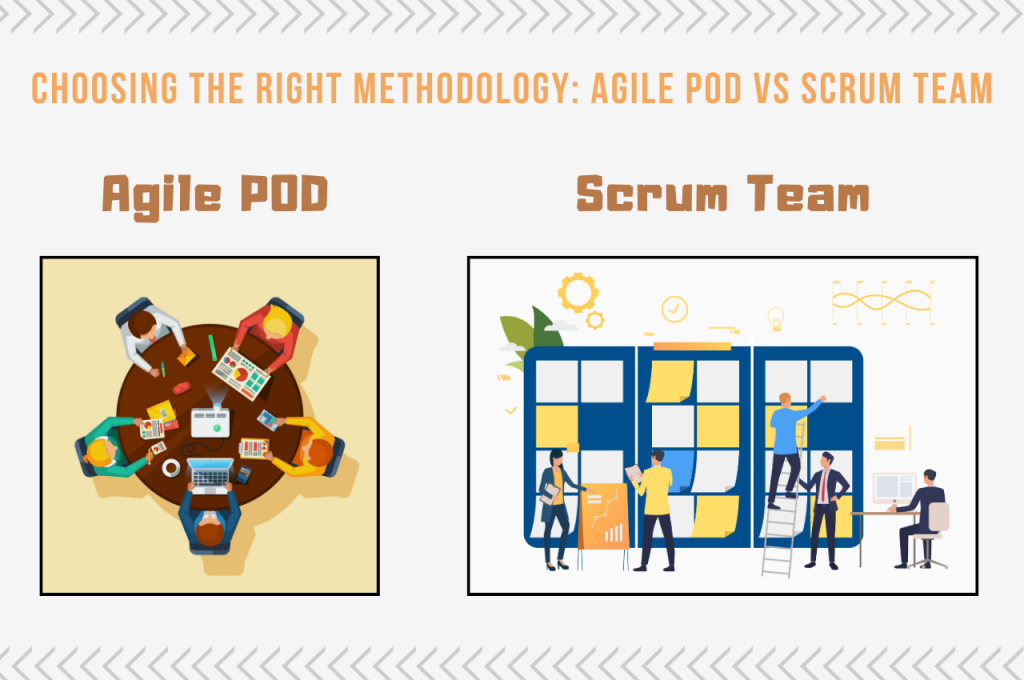The modern business landscape prioritizes maximizing productivity without sacrificing quality. This has led to a significant shift, particularly within the tech companies, towards embracing flexible work models. Consequently, Agile and Scrum methodologies, which emphasize collaboration and rapid software development cycles, have witnessed widespread adoption. These approaches empower teams to work together effectively and deliver results quickly.
Agile PODs and Scrum teams are both approaches used in software development, but they have some differences in their structure, focus, and methodology.

Here’s an overview of each approach:
Agile PODs
1. Cross-functional Teams:
Agile PODs typically consist of cross-functional teams that include members with different skills and expertise necessary to deliver a complete product or feature.
2. End-to-End Responsibility:
PODs often have end-to-end responsibility for delivering a specific product, feature, or outcome. This means they are responsible for all aspects of the development process, from ideation to deployment and maintenance.
3. Autonomous:
Agile PODs are often granted a high degree of autonomy in decision-making. They have the authority to make decisions related to their work without constant oversight.
4. Flexibility:
PODs are designed to be flexible and adaptable to changing requirements or priorities. They can adjust their focus and priorities based on feedback and evolving business needs.
5. Continuous Delivery:
PODs often emphasize continuous delivery and aim to deliver value to customers frequently and consistently.
Structure of Agile PODs: Flexible Team
Focus: Composed of specialists with the skills necessary to complete a specific task or project.
Flexibility: Team size and composition can change throughout the project based on evolving requirements.
Roles can include:
- Product Owner (represents stakeholders)
- Developers (with diverse skillsets like front-end, back-end, full-stack)
- User Experience (UX) Designer
- Quality Assurance (QA) Engineer
- Additional specialists as needed (e.g., dev ops engineer, data scientist)
How to implement an Agile POD framework in your organization?
1. Assess your needs and suitability:
Agile PODs are well-suited for complex projects requiring diverse skill sets and the ability to adapt quickly. Ensure you have the resources to form cross-functional teams with specialists in various areas. A culture that embraces collaboration, open communication, and adaptability is crucial for successful POD implementation.
2. Define your POD structure:
Identify project requirements: Analyze the skills and expertise needed to complete specific features or functionalities & build teams with specialists possessing the necessary technical and non-technical skills (e.g., communication, problem-solving). Aim for smaller, more focused teams (typically 4-8 members) to enhance collaboration and agility.
3. Establish clear roles and responsibilities:
Product Owner: Represents stakeholders, prioritizes the backlog for each POD, and ensures alignment with the overall product vision.
POD Lead: Facilitates communication within the POD, manages the workflow, and removes roadblocks.
Team Members: Contribute their expertise to complete the assigned tasks and functionalities.
4. Implement Agile practices:
Break down work into manageable chunks (e.g., sprints) with regular delivery of working features and have daily communication within the POD to discuss progress, identify roadblocks, and adapt plans as needed.
5. Tools and Communication:
Utilize tools like Jira, Trello, or Asana to manage tasks, track progress, and foster collaboration within the POD.
Scrum Teams
1. Roles and Artifacts:
Scrum teams follow the Scrum framework, which defines specific roles (such as Scrum Master, Product Owner, and Development Team) and artifacts (such as Product Backlog, Sprint Backlog, and Increment).
2. Time-Boxed Iterations:
Scrum teams work in time-boxed iterations called sprints, typically lasting 1-4 weeks. During each sprint, the team commits to delivering a potentially shippable product increment.
3. Scrum Events:
Scrum teams participate in several events, including Sprint Planning, Daily Standups, Sprint Review, and Sprint Retrospective, which help them plan, synchronize, and inspect/adapt their work.
4. Self-Organization:
Like Agile PODs, Scrum teams are self-organizing, meaning they have the autonomy to determine how best to accomplish their work within the constraints of the Scrum framework.
5. Focus on Transparency and Inspection:
Scrum emphasizes transparency, inspection, and adaptation. The team regularly inspects its progress and adapts its approach to improve productivity and quality.
Structure of Scrum Team: Predefined Team With Roles
- Product Owner: Represents stakeholders and prioritizes the product backlog.
- Scrum Master: Facilitates communication, removes roadblocks, and ensures adherence to Scrum principles.
- Development Team: Cross-functional group with the skills to deliver a product increment within a sprint (typically 2-4 weeks).
How to implement a Scrum team framework in your organization?
1. Preparation and Understanding:
Educate yourself and your team and enroll in Scrum training or workshops to gain a thorough understanding of the core principles, roles, and ceremonies. Assemble a cross-functional team with the necessary skills as your Scrum team.
2. Implementing the Scrum Framework:
Start by Sprint planning, conduct a collaborative session, standup meetings (typically 1-2 days) to select items from the product backlog for the upcoming sprint and also to estimate the work efforts required for each task by the team members. The Product Owner is available to clarify requirements and address any arising issues.
3. Inspecting and Adapting:
At the end of the sprint, hold a review session with stakeholders and the development team. Showcase the completed work and gather feedback. You can also have a team-only meeting to discuss what went well, what challenges were faced, and how the process can be improved for future sprints.

How ISHIR Can You in Implementing Agile Methodology in 2024
While both Agile PODs and Scrum teams operate within the agile methodology and emphasize collaboration, autonomy, and adaptability, they differ in their specific structures, methodologies, and frameworks. Agile PODs focus on end-to-end responsibility and flexibility, while Scrum teams adhere to the roles, events, and artifacts defined by the Scrum framework, working in time-boxed iterations with a focus on transparency and inspection.
In the case of ISHIR, Agile PODs utilize agile scrum methodologies to run product teams. Our Agile PODs embrace agile principles and practices to deliver value to ambitious start-ups and enterprises. They could employ agile frameworks such as Scrum, Kanban, or a combination of various agile practices tailored to the organization’s needs.





